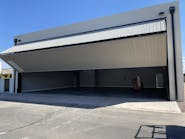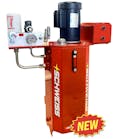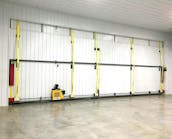NATA Releases Aircraft Hangar Fire Protection Guidance
The National Air Transportation Association (NATA) has released Aircraft Hangar Fire Protection Guidance — an educational guide for hangar owners and operators seeking a general understanding of updated hangar foam suppression system requirements, options, and alternatives.
“When the 2022 edition of NFPA 409: Standard on Aircraft Hangars was released in October 2021, changes to the standard raised questions on how the new requirements would impact both existing hangars and new hangar construction,” stated NATA Managing Director of Industry & Regulatory Affairs Megan Eisenstein.
NATA developed the Aircraft Hangar Fire Protection Guidance to further educate its members on the impact of two NATA-supported revisions to NFPA 409: Standard on Aircraft Hangars approved by the National Fire Protection (NFPA) Technical Committee on Airport Facilities:
• Create a new risk-based process for determining/defining hangar fire protection requirements – applicable to both new and existing hangars.
• Exempt Group II hangars where hazardous operations are not performed from the foam requirements within NFPA 409.
“Aircraft Hangar Fire Protection Guidance provides the industry with a better understanding of what codes are now in effect, how they are applicable, and how to move forward with eliminating foam from aircraft hangars,” added Eisenstein.
Available free online, NATA’s Aircraft Hangar Fire Protection Guidance details the following subject areas:
• Applicable Codes and Hangar Classification
• Code Exceptions and How to Avoid Foam
• If Foam is Required and Other Considerations
• Foam System Recommendations
• Frequently Asked Questions
The latest resource supporting NATA’s Hangar Foam Fire Suppression System Initiative includes a flow chart on various options to achieve code compliance relative to fire suppression systems based on the International Building Code (IBC), 2021 edition; International Fire Code (IFC), 2021 edition; and NFPA 409, 2016 edition.
“The National Air Transportation Association has been on the front line in educating the NFPA Technical Committee on the unique operating environment of general aviation businesses. Just as importantly, we’ve continued to work alongside our members to guide them throughout the entire process of hangar fire protection and to inform them of how NFPA 409 developments and requirements impact their operations,” stated NATA President and CEO Timothy Obitts.
The following members helped develop the guide: Doug Fisher, Fisher Engineering; Curt Castagna, Aeroplex Group Partners; and Dan Bianco, JRMA.



